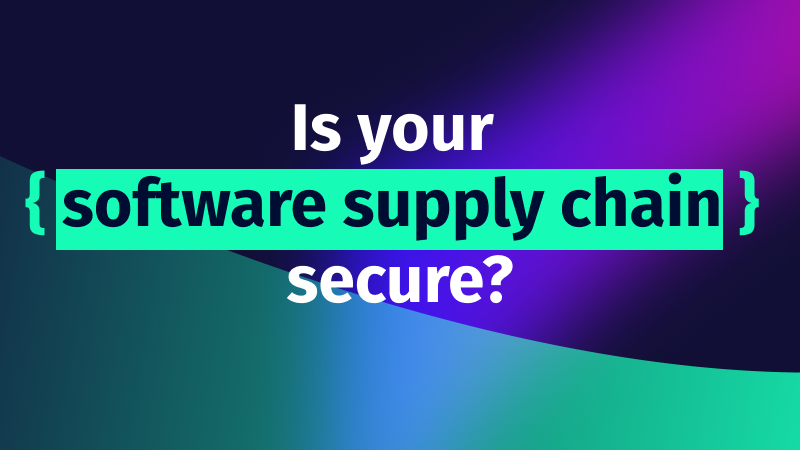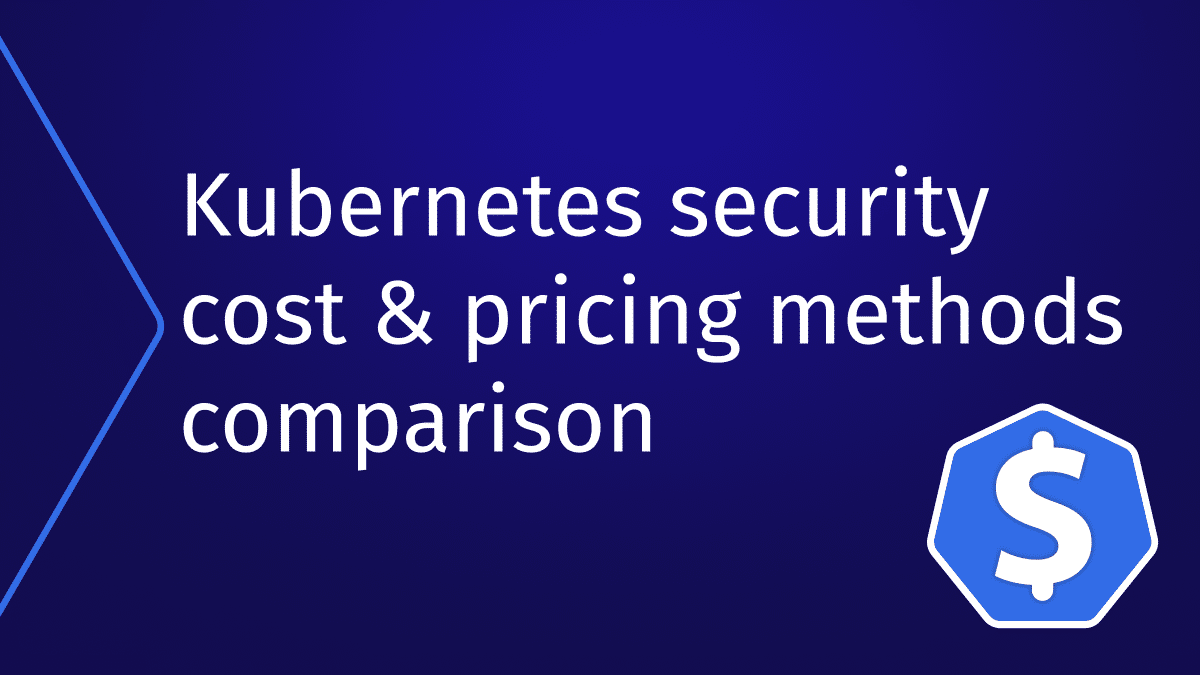Software Supply Chain Security: A Detailed Explanation
Software supply chain attacks cost businesses $45.8 billion globally in 2023 alone, and is projected...

Sep 23, 2024
Kubernetes today is the de facto standard for container orchestration, deployment automation, scaling, and management of containerized apps. The robustness and scalability of this open-source platform make it a valuable tool for businesses leveraging cloud-native technologies and DevOps practices.
However, as with any technology that handles sensitive data and crucial operations, the importance of security in Kubernetes environments can’t be overstated. Given the increase in cybersecurity threats and the rising costs of data breaches, ensuring the safety of your Kubernetes clusters is a top priority.
This article will delve into Kubernetes security, focusing on the concept of runtime security, its importance, and the efficacy of solutions offered by state-of-the-art platforms. Let’s begin with an overview of Kubernetes security, discuss its limitations, and then explore why runtime security is so crucial.
Security in Kubernetes is multi-layered and complex, reflecting the platform’s rich feature set and various use cases. Examples of Kubernetes’ built-in security offerings are role-based access control (RBAC), which helps limit who can access what resources; Network Policies, which control the flow of traffic between pods; and Pod Security Standards, which governs the privileges that pods have.
These tools are highly effective. However, as Kubernetes clusters grow and evolve, securing them becomes increasingly complex, which can lead to misconfigurations and exposure to vulnerabilities if not managed carefully.
Insecure Kubernetes environments can expose businesses to numerous risks. These include data breaches that can lead to the loss of sensitive information; service disruptions that can affect availability; and resource hijacking, where attackers use compromised resources to run unauthorized processes. Moreover, regulatory requirements can impose strict guidelines for protecting data and infrastructure, often with substantial penalties for non-compliance. GDPR and HIPAA are two significant examples of privacy laws at the EU and U.S. federal levels, respectively.
All of this means that maintaining a secure Kubernetes environment is a technical challenge as well as a legal and business imperative.
As mentioned, Kubernetes’ built-in security features are not without their limitations. They are primarily focused on access control and configuration policies, and while they are essential, they cannot guarantee the detection and prevention of all potential threats.
Because of this, securing Kubernetes requires additional measures beyond what the platform offers by default. And this necessitates understanding and applying runtime security.
Runtime security refers to the protective measures implemented to safeguard applications and data during their execution or runtime. It includes monitoring system activities, detecting and mitigating threats, and enforcing security policies while the system is operational. Unlike traditional, static security measures that focus on preventative measures—like firewall configurations and antivirus software—runtime security is dynamic.
In the context of Kubernetes, the need for runtime security becomes even more pronounced, given the dynamic nature of containers. Containers are often short-lived, creating a continually changing environment that can be hard to protect. Because of this, you should check the contents of container images prior to deployment for images compromised by vulnerabilities. In addition, Kubernetes encapsulates containers with higher-level resources such as deployments, ingresses, or network policies. These resources define and control how the container images will run in the clusters and how they behave in runtime, so again, their contents should be analyzed and ensured beforehand.
Runtime security is, therefore, a pivotal part of a robust security strategy in Kubernetes, complementing the platform’s built-in static security measures and providing much-needed visibility.
There are two types of security scanning methods: static and dynamic. Both are integral to maintaining a secure environment, and understanding their pros, cons, and use cases is critical.
Static application security testing (SAST), often referred to as “static scanning,” is a process that allows you to analyze source code without actually running the application. Typically implemented during the development phase, it is an effective tool for detecting vulnerabilities within the code, identifying misconfigurations, and ensuring compliance with coding standards.
Static scanning is a proactive security measure crucial for creating distributed and scalable systems. However, it’s also important to recognize its limitations. One major drawback is that it can only identify vulnerabilities known at the time of development or a scan. New vulnerabilities and threats emerge daily, so while static scanning is a valuable tool, it is insufficient as a standalone security measure.
Also, as a method that primarily focuses on the application layer, it is essential to note that SAST is not designed for environments like Kubernetes.
Consequently, in the broader application security context, static scanning should be supplemented with dynamic scanning and other real-time security measures to create a comprehensive and robust security protocol. This combination provides a more continuous evaluation of potential risks, adapting to the ever-evolving landscape of cybersecurity threats.
Dynamic scanning, or “dynamic application security testing” (DAST), on the other hand, examines the application during its execution. It provides a real-world view of the application’s behavior under various conditions, helping identify security issues that might occur only during runtime, such as runtime injection attacks or access control issues.
Dynamic scanning can sometimes lead to false positives, as it may interpret certain features or behaviors as security risks. Moreover, it is usually performed after the application has been deployed, which means it could be too late to prevent the exploitation of a vulnerability.
Despite their individual shortcomings, organizations should adopt an integrated approach that embraces both static and dynamic scans to achieve comprehensive security coverage of potential vulnerabilities at all stages of the application lifecycle. This will enhance your Kubernetes security posture and better protect your clusters against various threats.
As you endeavor to secure your Kubernetes environments, several methods can be employed to boost your security posture.
This process involves examining container images for known vulnerabilities. Integrating this practice into your CI/CD pipeline lets you detect potential security risks before deploying the containers. As a proactive measure, image scanning helps minimize the risk of deploying compromised containers into your Kubernetes environments.
While scanning helps identify vulnerabilities, managing them is a continuous process. This includes prioritizing vulnerabilities based on their severity, relevancy and potential impact, fixing or mitigating them, and verifying that the fixes have been successful. Effective vulnerability management can significantly reduce your risk exposure over time.
Kubernetes relies heavily on declarative configurations, often manifested as YAML files. Ensuring these files are properly configured to prevent inadvertent security exposures is crucial. Scanning for misconfigurations is based on policies encoded in security controls. These scans aim to identify any configurations that may pose security risks and reveal non-compliance with established security best practices.
The techniques above are summarized in the table below:
| Technique | Explanation | Benefits |
| Container image scanning | Examining container images for known vulnerabilities | Identifies risks before deployment |
| Vulnerability management | Prioritizing, fixing, and verifying vulnerabilities | Reduces risk exposure over time |
| Misconfiguration scanning | Checking Kubernetes’ YAML files for risky and unwanted configurations and non-compliance | Ensures configurations align with security best practices and policies |
ARMO, a leader in Kubernetes security, has developed solutions that address each of these methods, making it an ideal platform for businesses looking to enhance their Kubernetes security.
ARMO, the company behind ARMO Platform and an innovator in the cybersecurity space, is dedicated to revolutionizing Kubernetes security. ARMO Platform provides a comprehensive, multi-layered approach to securing Kubernetes deployments, addressing a wide range of potential security threats. By offering a combination of features designed to boost Kubernetes security, ARMO provides a solution that is as robust and holistic .
ARMO Platform, powered by Kubescape, empowers users to ensure their Kubernetes deployments conform to security best practices. It goes beyond simply identifying potential misconfigurations and vulnerabilitie.It offers auto-remediation for misconfigurations and pinpoints the vulnerabilities that matter most to your security posture.
ARMO Platform aligns seamlessly with the fundamental security techniques previously discussed. Here’s an analysis of how:
| Technique | ARMO Solution |
| Container image scanning | Integrates with the CI/CD pipeline to scan container images for vulnerabilities, helping you catch and mitigate potential risks before deployment |
| Vulnerability management | Helps you manage vulnerabilities effectively, prioritizing them based on their severity and relevancy |
| Misconfiguration scanning | Allows you to enforce security compliance by scanning Kubernetes configuration files and ensuring they adhere to defined policies |
ARMO Platform is designed to not only secure your Kubernetes environments but to also integrate smoothly with your existing workflows.Thus, making Kubernetes security a seamless part of your overall operations.
In the rapidly evolving world of technology, where Kubernetes has become an integral part of modern infrastructure, ensuring the security of your Kubernetes environments is more than a best practice—it’s a necessity. But not just any security measures will suffice. Kubernetes environments, with their unique characteristics and complexity, call for Kubernetes-native solutions that truly understand and cater to their needs.
While Kubernetes’ built-in security features provide a solid foundation, the dynamic nature of threats necessitates a more comprehensive approach.
This is where ARMO steps in. Its Kubernetes-native solution, ARMO Platform, is specifically designed to address the complex security challenges inherent to Kubernetes environments. ARMO’s Kubernetes security solution not only complements the security features of Kubernetes but also goes the extra mile in providing additional layers of protection essential for a robust security posture. Secure your Kubernetes deployments, protect your data, and ensure the smooth operation of your services with Kubernetes-native solutions. Experience ARMO, and take the first step toward achieving a secure, resilient Kubernetes environment.

Software supply chain attacks cost businesses $45.8 billion globally in 2023 alone, and is projected...

Imagine this situation: you recently updated one of your infrastructure software components. A few weeks...

It is becoming increasingly important for organizations to manage Kubernetes security costs as they deploy,...